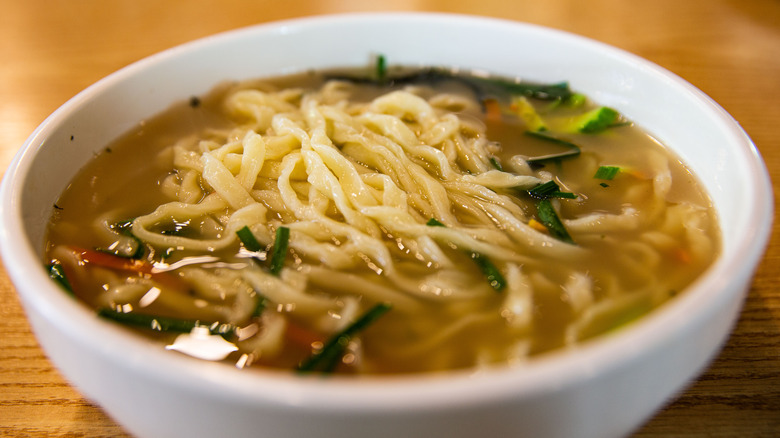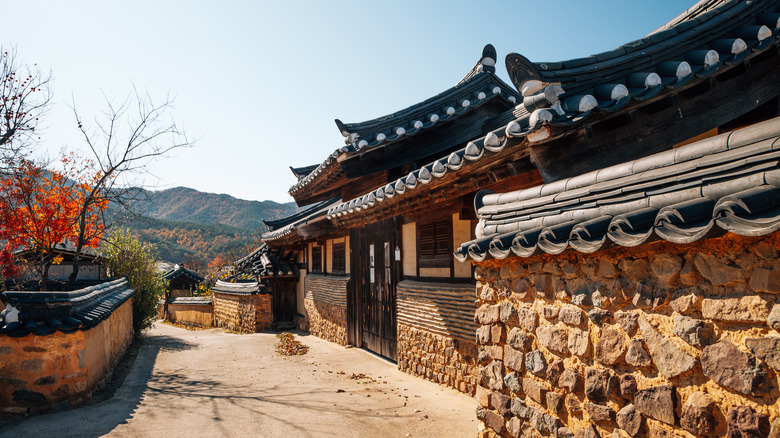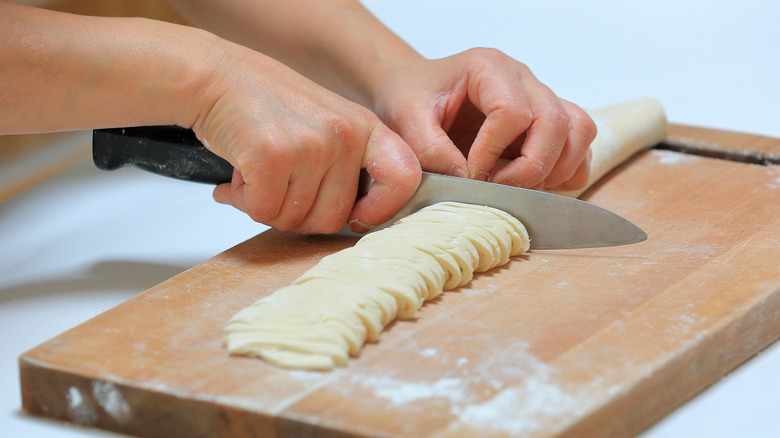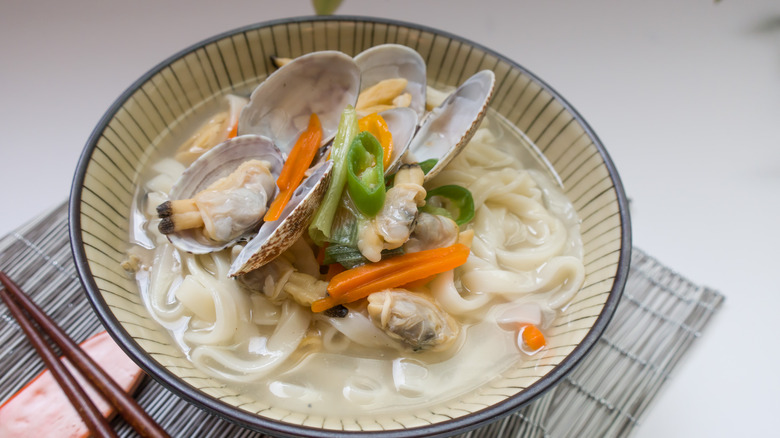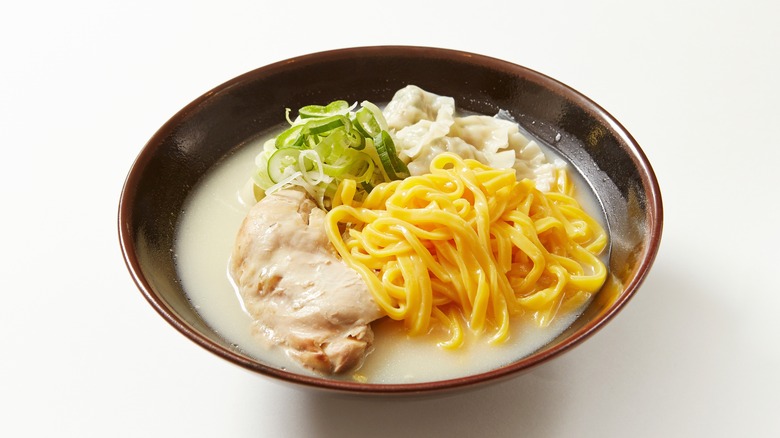What Makes Korea's Kalguksu Noodle Soup Unique
There's nothing more satisfying on a cold day than a bowl of hot soup. But for many Koreans, the best time to have really hot soup is on a hot and muggy day, Korean Bapsang says. In the Land of Morning Calm, it is believed by many that eating hot soup on a hot day can help a person to cool down and improve their energy.
A popular type of soup with several regional varieties that gets consumed on hot and cold days in Korea is kalguksu, which can be made with a variety of vegetables and different types of broth. A protein, such as chicken or seafood, is often added to kalguksu, but its most important ingredient is the one from which it gets its name — noodles. Translated from Korean, kalguksu means "knife noodles," per Korean Bapsang, referencing how they are created by cutting the dough with a knife. Often served with a side of kimchi, kalguksu is bound to warm you up or cool you down, depending on the weather.
A food for the elite
Koreans have been dining on hot bowls of kalguksu for centuries, according to MasterClass, which chronicles that the first servings of the soup were likely prepared between 918 AD and 1392 AD. At that time, it wouldn't have been the average person who would have gotten to eat kalguksu. Because noodles were expensive, they were reserved for the wealthy, MasterClass says. Several centuries later, the soup first recognized as kalguksu was recorded in 1670 in a cookbook called "Eumsik Dimibang" from Lady Jang Gye-Hyang. Even though the recipe had been published, that didn't mean it was accessible for the masses. In fact, it wasn't until after the Korean War ended in 1953 that more wheat was imported into Korea and that noodles became less expensive and more available for everyone.
The most authentic variation of kalguksu reflects its origins of being a food for only a few. According to Kimchimari, the classic version of kalguksu is known as Andong, and it shares the name of a city in South Korea, south of Seoul. The area had a reputation for making high-quality foods for the royal family and elite members of society. Kimchimari says it wasn't until the 1980s that kalguksu became familiar in the South Korean capital of Seoul.
How kalguksu is prepared
The broth and ingredients used are important for kalguksu, but the noodles are really the centerpiece. While premade noodles are available for sale, Kimchimari says it's well worth the effort to make them from scratch. Another plus to making them at home is that it's a fairly uncomplicated process.
Unlike a lot of noodles that require the maker to pull the dough to stretch it out, kalguksu relies on the cook's knife skills to create long noodles. After making the dough and allowing it to rest, it is rolled out and then folded four to five times, per Kimchimari. Then, the folded dough is cut with a knife to create long noodles, which should be unfolded and loosened after being cut. To keep them separated before being cooked, they should be sprinkled with flour to prevent them from sticking together.
Kalguksu recipes have different directions for how the soup is made, but generally the broth is made and then vegetables are added to the pot, followed by noodles. Toppings, such as green onions and chopped garlic, can be added during the cooking process or closer to the end, depending on the desired taste.
Variations of kalguksu
Of the different variations of kalguksu, chicken, or dak kalguksu, is one of the most popular, per Korean Bapsang, but there are several more regional takes on kalguksu that incorporate popular local ingredients. A variety with littleneck clams is called bajirak kalguksu, per MasterClass, and is especially popular in the Jeolla province, Kimchimari adds. For those who really love seafood, the haemul kalguksu should be the go-to version, as it includes seafood and shellfish, with prawns and octopus being two popular ingredients. When it comes to making kalguksu, a wide range of ingredients are suitable for the dish, from snails to pheasant and beans to kimchi, advises MasterClass.
A style of kalguksu has become popular in Seoul that incorporates a broth made of anchovies and beef with pieces of beef and zucchini in the soup, per Kimchimari. Other lesser-known varieties include those made with perilla seed powder or seaweed, and there's a spicy version made with gochujang and gochukaru.
There are even some variations on the noodles. In addition to the common flour and eggs to make the dough, some cooks add dried bean powder or mashed mung beans to the dough to make the noodles firmer. For an herbier flavor, mugwort can be incorporated into the dough.
Common ingredients in kalguksu
While the heart of kalguksu may be its noodles, vegetables, meat, and stock still play an important role in the soup's composition. The most common vegetables for a pot of kalguksu, according to Korean Bapsang, are onion, zucchini, carrot, and potato. A simple and classic recipe for kalguksu from MasterClass calls for anchovy or fish stock, a garlic clove, soy sauce, carrot, courgette (a type of zucchini), dried kalguksu noodles, and salt and pepper with sliced green onions to garnish.
If a heartier soup is preferred, My Korean Kitchen recommends dak kalguksu (chicken kalguksu), but her personal favorite is bajirak kalguksu, which is made with littleneck clams. The soup is light, but still flavorful. Accompanying the littleneck clams in bajirak kalguksu are several ingredients, including zucchini, carrots, and shiitake mushrooms. A recipe for chicken kalguksu varies from the other varieties of kalguksu in that it has onion, sliced ginger, and optional dry kelp. The whole chicken used for the soup is prepared with garlic and sesame oil. For a little more flavor and heat, there is an optional sauce called yangnyumjang made of soy sauce, sesame oil, red pepper flakes, sesame seeds, minced garlic, and scallions, per Korean Bapsang. She recommends serving it on the side to be added in as the diner wishes.
